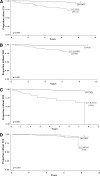Pancreatic islet autoantibodies as predictors of type 1 diabetes in the Diabetes Prevention Trial-Type 1
- PMID: 19741189
- PMCID: PMC2782989
- DOI: 10.2337/dc09-0934
Pancreatic islet autoantibodies as predictors of type 1 diabetes in the Diabetes Prevention Trial-Type 1
Abstract
Objective: There is limited information from large-scale prospective studies regarding the prediction of type 1 diabetes by specific types of pancreatic islet autoantibodies, either alone or in combination. Thus, we studied the extent to which specific autoantibodies are predictive of type 1 diabetes.
Research design and methods: Two cohorts were derived from the first screening for islet cell autoantibodies (ICAs) in the Diabetes Prevention Trial-Type 1 (DPT-1). Autoantibodies to GAD 65 (GAD65), insulinoma-associated antigen-2 (ICA512), and insulin (micro-IAA [mIAA]) were also measured. Participants were followed for the occurrence of type 1 diabetes. One cohort (Questionnaire) included those who did not enter the DPT-1 trials, but responded to questionnaires (n = 28,507, 2.4% ICA(+)). The other cohort (Trials) included DPT-1 participants (n = 528, 83.3% ICA(+)).
Results: In both cohorts autoantibody number was highly predictive of type 1 diabetes (P < 0.001). The Questionnaire cohort was used to assess prediction according to the type of autoantibody. As single autoantibodies, ICA (3.9%), GAD65 (4.4%), and ICA512 (4.6%) were similarly predictive of type 1 diabetes in proportional hazards models (P < 0.001 for all). However, no subjects with mIAA as single autoantibodies developed type 1 diabetes. As second autoantibodies, all except mIAA added significantly (P < 0.001) to the prediction of type 1 diabetes. Within the positive range, GAD65 and ICA autoantibody titers were predictive of type 1 diabetes.
Conclusions: The data indicate that the number of autoantibodies is predictive of type 1 diabetes. However, mIAA is less predictive of type 1 diabetes than other autoantibodies. Autoantibody number, type of autoantibody, and autoantibody titer must be carefully considered in planning prevention trials for type 1 diabetes.
Figures


References
-
- Bottazzo GF, Florin-Christensen A, Doniach D: Islet cell antibodies in diabetes mellitus with autoimmune polyendocrine deficiencies. Lancet 1974; 2: 1279– 1282 - PubMed
-
- Lendrum R, Walker G, Cudworth AG, Theophanides C, Pyke DA, Bloom A, Gamble DR: Islet-cell antibodies in diabetes mellitus. Lancet 1976; 2: 1273– 1276 - PubMed
-
- Gorsuch AN, Spencer KM, Lister J, McNally JM, Dean BM, Bottazzo GF, Cudworth AG: Evidence for a long prediabetic period in type I (insulin dependent) diabetes mellitus. Lancet 1981; 2: 1363– 1365 - PubMed
-
- Palmer JP, Asplin CM, Clemons P, Lyen K, Tatpati O, Raghu PK, Paquette TL: Insulin antibodies in insulin-dependent diabetics before insulin treatment. Science 1983; 222: 1337– 1339 - PubMed
-
- Wilkin T, Hoskins PJ, Armitage M, Rodier M, Casey C, Diaz JL, Pyke DA, Leslie RD: Value of insulin autoantibodies as serum markers for insulin-dependent diabetes mellitus. Lancet 1985; 480– 481 - PubMed
MeSH terms
Substances
Grants and funding
LinkOut - more resources
Full Text Sources
Other Literature Sources
Medical
Research Materials
Miscellaneous

